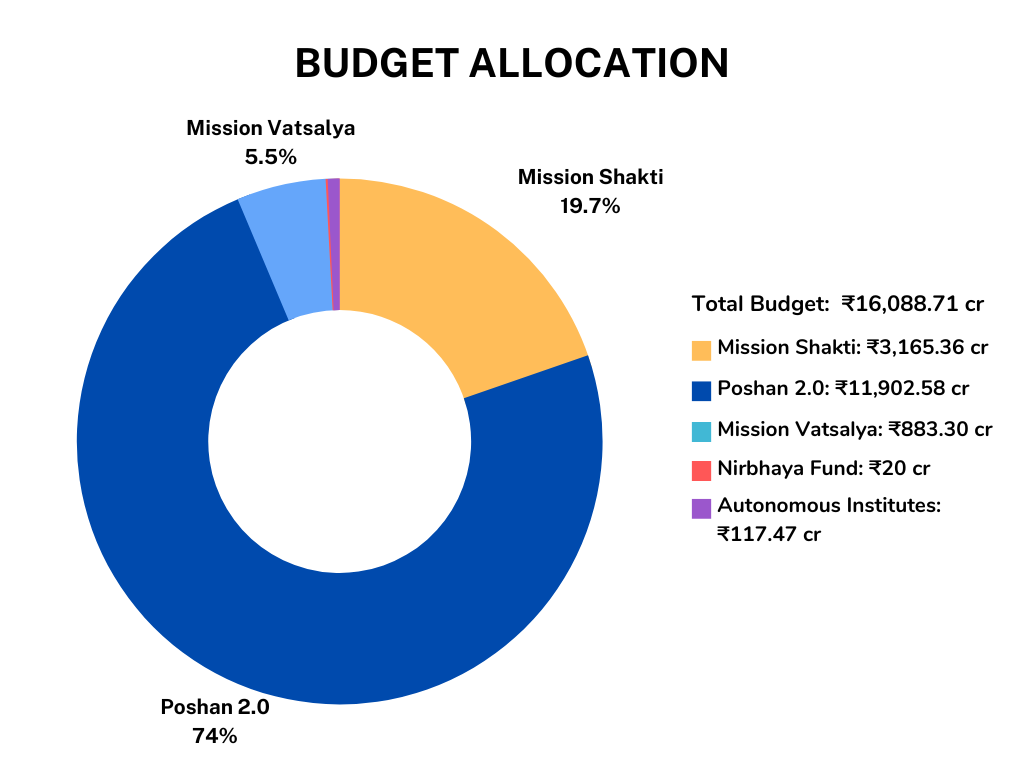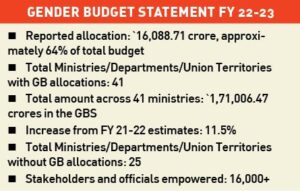
The concept of gender budgeting concentrates on gender-based and equality-focused assessment for redistribution of economic resources. The goal of such a budget is to support measures for gender parity by utilising the resources available and implementing optimal techniques, and procedures during a budget cycle.
Gender budgets were established to promote economic equality, proving to be an important policy practice for women worldwide (OECD 2022). It is also referred to as Gender Sensitive Budgeting (GSB) and Gender Responsive Budgeting (GRB). Gender-sensitive or responsive budgets are crucial tools that equip policymakers to ensure both men and women get equitable benefits of development, in turn facilitating “gender mainstreaming”. Drafting and implementing such budgets are not just balancing acts but should be an ongoing process of developing, implementing, and reviewing policies and/or programmes that look at equality and equity from a gender-centric perspective.
The Indian Government has implemented gender budgets since the early 2000s. Over the years, the government has put in place a number of fiscal, regulatory, and structural policies and mechanisms expressly for the purpose of gender mainstreaming. The Ministry of Women and Child Development (MWCD), as the nodal Ministry for such budgets, has emphasised that GB is not merely “the earmarking of funds for women and girls but creating a positive impact in their lives and bridging gender gaps.”
BY THE NUMBERS
The MWCD, following its mandate of advancing women and girls’ empowerment, has continued to draft substantial gender budgets. The Ministry reported an allocation of `16,088.71 crore in the Gender Budget Statement for the Financial Year 2022-23, which is approximately 64 percent of its total budget estimates.
This included gender budget allocations such as: `3,165.36 crore for Mission Shakti under Sambal and Samarthya components to provide unified citizen-centric lifecycle support for women through integrated care, safety, protection, rehabilitation and empowerment; `11,902.58 crore under Saksham Anganwadi and Poshan 2.0; `883.30 crore under Mission Vatsalya for protection and institutional care of girl children; `20 crore under Nirbhaya Fund and `117.47 crore under autonomous institutions including National Commission for Women, Central Social Welfare Board, NIPCCD, CARA and NCPCR.
As part of Mission Shakti for empowerment of women, MWCD aims to achieve 100% coverage of GB in central Ministries/Departments and States/Union Territories. The Ministry’s strategic focus is on establishing and strengthening institutional mechanisms and processes to undertake Gender Budgeting at the national and sub-national levels; developing internal and external capacities and building expertise across sectors to integrate a gender perspective in planning, budgeting and auditing.
INSTITUTIONAL MECHANISMS AND PROCESSES
Gender Budget Statement and Reporting Allocations: The Budget is an important entry point to apply a gender lens in the entire policy spectrum. A Gender Budget Statement (Statement 13 of the Expenditure Profile) is published annually along with the Union Budget since 2005-06. The Gender Budget Statement (GBS) is a gender-specific accountability document produced by the Government of India with the Union Budget. It is a reporting mechanism for Ministries and Departments to review their programmes from a gender perspective and present information on allocations for women and girls.
In 2022-23, 41 Ministries, Departments and Union Territories reported an amount of `1,71,006.47 crores in the GBS, an increase of 11.5 percent over 2021-22 (Budget Estimates). To provide handholding support to central Ministries and Departments to report in the GBS as mandated in the Budget Circular, the MWCD conducted gender budget analysis of schemes of 25 Ministries and Departments that did not report in the GBS or reported negligibly with technical support from UN Women.
Budget cells: The Ministry of Finance mandated the setting up of Gender Budget Cells (GBCs) to implement Gender Budgeting initiatives in each Ministry and Department in 2004-05. In April 2014, the Expenditure Finance Committee (EFC) document included a gender perspective at the planning stage for all new programmes, projects, and schemes. Section 3 of the EFC format specifically mentions: “If the scheme has any gender balance aspects or components specifically directed at the welfare of women please bring them out clearly.”
Gender-sensitive checklists: The MWCD has set specific guidelines in the form of Checklist I (beneficiary-oriented programmes that target women) and Checklist II (mainstream sectors and programmes), gender appraisal of schemes and policies based on a Five-Step Framework, and spatial mapping. These guidelines help in reviewing public expenditure from a gender perspective to enable gap identification and measures to enhance gender responsiveness of schemes and budgets.
CAPACITY BUILDING
A key focus area of the GB Division, MWCD is to continue strengthening capacities and building expertise on GB of key officials at the National, State and District Level. The Ministry focused on the following: organising and supporting GSB workshops; state initiatives on GB; technical assistance; collaborations with key stakeholders.
Organising and supporting GSB workshops: Since 2007–08, MWCD has been implementing a Gender Budgeting Scheme to provide financial grant-in-aid to government departments, national and state training institutes, and organisations to conduct training and workshops.
Through the Scheme, capacities of over 16000 officials and stakeholders on GB have been enhanced. These capacity building exercises involve: 1. Addressing the gap between policy commitment and allocation for women through adequate resource allocation and gender-sensitive programme formulation and implementation; 2. Mainstreaming gender concerns in public expenditure and policy and; 3. Enhancing knowledge and skills on gender budgeting tools and mechanisms.
State initiatives: MWCD has made consistent efforts to support the institutionalization of GB at the State level. To date, 27 States/Union Territories have undertaken GB initiatives to address gender gaps. The level of institutionalization in each State is varied and a range of GB mechanisms and processes have been implemented. These include the identification of a nodal Department and official for GB, the constitution of Gender Budget Cells, developing State GB Action Plans, publishing a Gender Budget Statement in the State Budget, linking outcome budgets with gender budgets, designating a nodal training institute, capacity building training, conducting gender audit/performance audits etc. During 2022-23, a total of 18 States and 6 Union Territories published Gender Budget Statements. A total of 21 States have designated nodal training institutes for capacity building on GB.
Technical assistance: To strengthen GB in the States, a Technical Assistance (TA) Project on ‘Advancing Gender Budgeting in Select States in India’ with the Asian Development Bank (ADB) and Japan Fund for Prosperous and Resilient Asia and the Pacific (JFPR) was initiated during 2020-21 with MWCD as the Executing Agency. The TA has been implemented by UN Women since August 2020 in four states, including, Andhra Pradesh, Himachal Pradesh, Madhya Pradesh, and Manipur with an aim to enhance institutional capacities in gender budgeting and gender mainstreaming of the state departments. The project ends on 31 May 2023. In the four select states, the project has focused on strengthening GB mechanisms; enhancing the capacity of GB of government stakeholders; developing customized knowledge products and training modules; and developing an e-governance tool on gender budgeting. As part of the TA Project, four state-specific scoping studies have been conducted in the project states based on which State Action Plans on GB were adopted. In 2022-23, state level meetings were conducted in all four states by the Inter-Departmental Monitoring Committees on GB respectively to review implementation of the action plans. Government of Himachal Pradesh published its first Gender Budget Statement in 2022-23, and Governments of Andhra Pradesh and Manipur published their second consecutive Gender Budget Statement along with respective state budgets.
Collaborations with stakeholders: A Broad-Based Committee for Gender Analysis and Budgeting was constituted in November 2019 comprising 12 Government representatives and 11 private stakeholders to evaluate and suggest actions for moving forward towards addressing gender concerns and reviewing action for advancing GB. Complementing the public policy tool of GB, this Committee is a significant policy change to ensure the gender analysis of budgets and the advancement of gender equality. As a first of its kind for GB, the Committee is a policy mechanism to review gender responsiveness of plans and allocations at the national level and suggest measures to improve the same. So far, six meetings including two review meetings of the Committee have been organised. In 2022-23, the Committee conducted a gender analysis of the Union Budget of the past three years and recommendations were drafted to strengthen gender responsiveness of plans and budgets in the form of a report that is under review.
WAY FORWARD
In 2022-23, a series of inter-ministerial meetings to promote gender budgeting across the central government, issuance of guidelines on gender budgeting and meetings of the Broad-Based Committee for Gender Analysis and Budgeting have been significant gains.
The recommendations of the Committee will majorly facilitate the mainstreaming of gender across sectors. Two new states initiated the implementation of gender budgeting in FY 2022-23. Across the country, Zonal and Cross-Zonal learning programmes created awareness of the good practices of gender budgeting in different states.
The Gender Budgeting Dashboard being developed as a one-stop portal on GB will serve as a repository of knowledge and information. These efforts will ensure the advancement of Gender Budgeting across various levels of governance and strengthen systems for equitable resource allocation.
